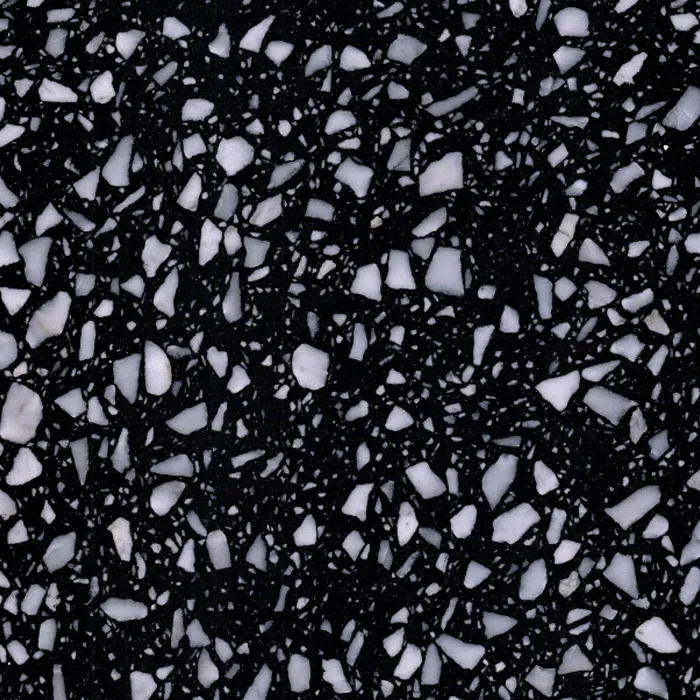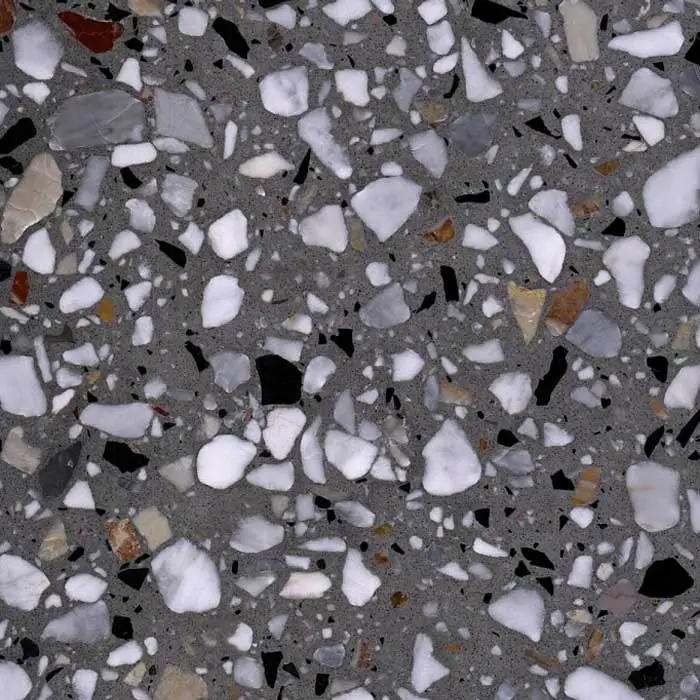Whether in commercial places or home environments, the unique texture and diverse designs of terrazzo stone are highly favored. However, many people have doubts about the nature of terrazzo stone: Is terrazzo stone an artificial stone or a natural stone?
This article will explore this issue in depth, and comprehensively analyze the nature of terrazzo stone by analyzing the composition, production process, historical background, etc. of terrazzo stone.

Composition and production process of terrazzo stone
To figure out whether terrazzo stone is an artificial stone or a natural stone, you first need to understand the composition and production process of terrazzo stone.
1. Composition of terrazzo stone:
Terrazzo stone is mainly made of a mixture of materials such as cement, sand, stone, pigment and additives. Its core materials are cement and stone, among which the stone can be natural crushed stone, granite, marble chips, etc. Pigments and additives are used to adjust the color and performance of terrazzo stone.
2. Terrazzo stone production process:
The production process of terrazzo stone is relatively complicated, mainly including the following steps:
● Mixing materials: Mix cement, sand, gravel, pigment and additives in proportion to form a uniform mixture.
● Casting and laying: Pour the mixture into a mold or lay it directly on the ground, and it will be initially compacted and leveled.
● Grinding and polishing: After the mixture hardens, it will be polished and polished several times to make the surface smooth and flat, and show the natural texture and color of the stone.
● Sealing and protection: Finally, the polished surface is sealed to enhance its stain resistance and wear resistance.
Artificial properties of terrazzo stone
From the composition and production process of terrazzo stone, it can be seen that terrazzo stone is a composite material that is artificially mixed and processed. This production method determines that the essential attribute of terrazzo stone is artificial stone, not natural stone.
1. Artificial mixed materials:
The core material of terrazzo stone is artificially mixed. Raw materials such as cement, sand, and gravel are mixed in proportion in the factory or construction site to form the required mixture. This process is different from the natural generation of natural stone, but completely relies on human intervention and processing.
2. Complex production process:
The production process of terrazzo stone includes multiple steps such as pouring, grinding, and polishing, and each step requires manual operation and control. This complex production process further highlights the artificial properties of terrazzo stone, which is essentially different from the mining and simple processing of natural stone.

Comparison between terrazzo stone and natural stone
In order to understand the artificial properties of terrazzo stone more clearly, we can compare it with natural stone.
1. Formation and mining of natural stone:
Natural stones such as marble and granite are minerals generated by nature after millions of years of geological action. These stones are directly used for construction and decoration through mining, cutting and simple processing, and their texture and color are naturally formed.
2. Characteristics of natural stone:
Natural stone has unique texture and color, and has high aesthetic value and decorative effect. At the same time, natural stone has a hard texture, good wear resistance and durability, but there may be natural flaws and cracks on its surface, which is also its uniqueness.
Historical background and development of terrazzo stone
As a man-made stone, the history of terrazzo stone can be traced back to the ancient Roman period. The ancient Romans used cement and crushed stone to create a durable and beautiful floor material. This technology was further developed in the European Middle Ages and introduced to China in the early 20th century, gradually becoming a widely used floor decoration material.
1. The development of early terrazzo stone:
In the ancient Roman period, terrazzo stone was mainly used for paving the floors of public buildings and squares. By mixing marble fragments and cement, the ancient Romans created a unique floor decoration effect. This technology was continued in the Middle Ages and reached new heights during the Renaissance.
2. The development of terrazzo stone in China:
In the early 20th century, terrazzo stone technology was introduced to China and quickly became widely used in China. Especially from the 1950s to the 1970s, terrazzo stone became a common floor material in Chinese urban buildings. Its durability and economy make terrazzo stone widely used in public buildings, schools, hospitals and other places.
3. Innovation and application of modern terrazzo stone:
With the advancement of technology and changes in design needs, modern terrazzo stone has made new developments in materials, processes and designs. By introducing new pigments and additives, the color and performance of terrazzo stone have been improved. At the same time, the application of digital design and customized production technology makes the patterns and textures of terrazzo stone more diverse.

Analysis of the advantages and disadvantages of terrazzo stone
As an artificial stone, terrazzo stone has many advantages in practical applications, but there are also some disadvantages.
1. Advantages of terrazzo stone:
● Wear-resistant and durable: terrazzo stone has high hardness and wear resistance, and can withstand high-intensity use and wear.
● Diversified design: By selecting stones of different colors and sizes, and adding different pigments, terrazzo stone can achieve diversified design effects to meet different styles and needs.
● Easy to maintain: The surface of terrazzo stone is smooth and flat, with good anti-fouling performance, and daily cleaning and maintenance are relatively simple.
● Environmental protection and health: The main raw materials of terrazzo stone are natural stones and cement, which do not contain harmful substances and meet environmental protection and health requirements.
● Affordable price: Compared with natural stone, terrazzo stone has a lower production cost, a relatively affordable price, and a high cost-effectiveness ratio.
2. Disadvantages of terrazzo stone:
● Complicated installation: The installation process of terrazzo stone is relatively complicated, requiring a professional construction team to operate, and the construction period is long.
● Strong cold and hard feeling: Terrazzo stone has a relatively hard texture and feels relatively cold underfoot, which is not suitable for areas that require warm and soft floors.
● Easy to scratch: Although terrazzo stone has good wear resistance, its surface is still easily scratched by hard objects, and protection should be taken during use.
● Possible fading: During long-term use, terrazzo stone may fade due to ultraviolet radiation, affecting the aesthetic effect.

Conclusion
Through the analysis of the composition, production process, historical background, etc. of terrazzo stone, it can be clearly seen that terrazzo stone is an artificial stone, not a natural stone.
Although the artificial properties of terrazzo stone determine its essential difference from natural stone, its unique advantages and broad application prospects still make it occupy an important position in the floor material market.

